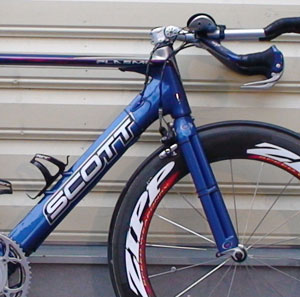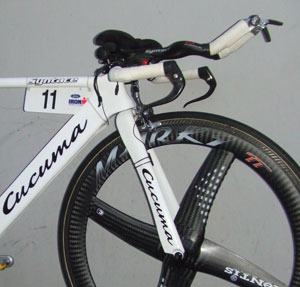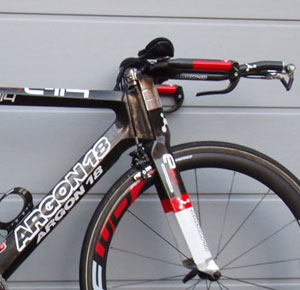David Thompson’s Litespeed
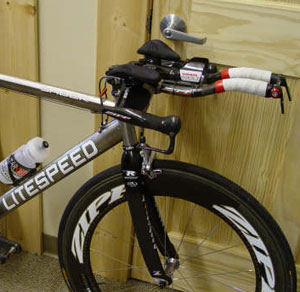
David Thompson is known as one of the fastest cyclists in the sport of triathlon and we asked him a few question about his bike and setup. Enjoy part 4 of our "the bikes of the pros" series.
ST: Can you tell us more about your choice of frame? What do you like about it the most and what would you improve if you were in charge?
David: In my opinion, titanium is the best material to make a bike out of. It’s extremely durable, which is a great attribute. For example, my bike gets thrown around a great deal traveling to 26 races over course of a season. I've also been in my fair share of crashes, but my titanium bike has always come away dent free and ready to ride. If your frame did get scraped up, all you have to do is buff it up with Scotch Brite and slap new decals on. It's like having a new bike for life. As far as performance, titanium rides superbly, is extremely light, aerodynamic, and looks great forever. Anyway, that is why I ride a Litespeed Saber. I'd prefer a slightly smaller head-tube, but the taller head-tube definitely suits the greater triathlete population much better.
ST: Who helped you with your bike fit or how did you arrive at your fit?
David: My fit was developed through extensive riding and what felt right to me. However, my position has been verified in the wind tunnel and using the new Retul fit measurement system. This isn’t how most people should go about fitting themselves, but it worked for me.
ST: You actually spent time in the wind tunnel to optimize your setup. Can you tell us about it?
David: I did spend time in a wind tunnel when Gear West took a trip to MIT last spring. However, I was in the tunnel as a subject for testing hydration and nutritional products. I didn’t directly benefit from position optimizing in the tunnel. However, I did design the testing protocol and analyze all the data we gathered that day, so I do have a good idea of what my drag is and what I can do to minimize it.
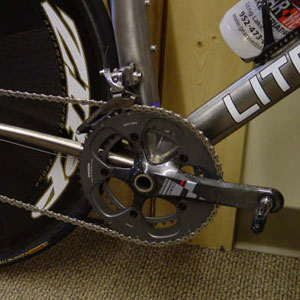
ST: I was amazed to see that you are not utilizing a power meter. Can you tell us about that?
David: I do use the wireless Power Tap on my training wheels, but you’re right, I don’t use any kind of power meter on my race set-up. My logic is that it’s much more important to have power feedback in training than it is in a race. In a race, my output is more dependent on the demands of the race, or more simply, I’m going to race as hard as I can in order to win. So, it doesn’t matter what a power meter is reading in a race. Granted, I don’t race the ironman distance events where pacing plays a much bigger role, and Power Tap isn’t disc compatible.
ST: Have you tried/tested other wheels before going with Zipp? Also, do you use the 1080/disc setup at most races or do you opt for shallower profiles in some cases?
David: Yeah, I rode Mavic and Hed wheels in the past, but I’ve always had a preference for Zipp wheels because of the innovation, quality, and the people behind the product. As far as the new 1080, I haven’t ridden it yet. The roads in St Paul are still covered by snow and ice so my first test trial will probably be my first race in 2008, the Desert Classic Duathlon in Phoenix. I will probably use the 1080 / Sub9 Disc set up for 25 out of my 26 races. The determining factor will probably be cross winds.
ST: You are utilizing the Reynolds Ouzo aero fork and we would like to know why you opted for that fork?
David: I like my Reynolds for its durability and usability. The fork’s compression plug and top cap design work great for continuous assembling and disassembling. However, I didn’t initial choose the fork. It came with my old Litespeed Blade, and I liked it enough to move it to my new Saber.
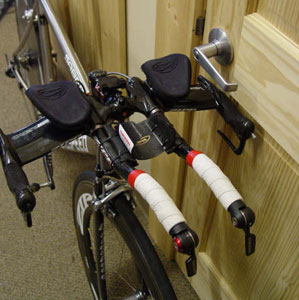
St: Is your aerobar setup as you would like or would you improve anything if you could?
David: The things I like about my aerobar set up is the choice of extensions, brake levers, pads, and overall quality. If I was to change anything, I would like to see more "drop" to the base bar hand position. However, there is also a draw back to adding more “drop.” It makes packing the bike in a bike box much more difficult. Taking this in to consideration, Zipp did a good job of making a bar anyone can love.
ST: Not too many pros have SRAM components on their bikes. How does he SRAM red compare to the Shimano Dura Ace you used prior?
David: So far, I’ve been extremely impressed with my SRAM Red components. However, my interaction with the components has been limited to installation and a trainer ride, but I am excited to get out on the road with the group this spring. Dealing with SRAM has also been enjoyable not only because of the product but because of the people behind the product.
ST: Many triathletes struggle with saddle comfort issue. Was that anything you had to deal with?
David: Yeah, building up thick skin, choosing a saddle cream, and licking my wounds (not literally) is something I’ve had to deal with when it comes to time in the saddle. However, my switch to the Fizik Arione Tri saddle has been an improvement. In general, saddles are tough because it can be different for everyone.
David Thompson personal specs:
– height: 185.4 cm
– inseam: 88 cm
– weight: 165 lbs
David Thompson bike details:
– frame: Litespeed Saber
– size: 57 cm
– bar drop: 17 cm
– saddle setback: 3.5 cm (tip to center of BB)
– saddle height: 80 cm (center of BB to center of saddle)
– fork: Reynolds Ouzo Aero Pro
– seat post: Real Design Carbon Proprietary
– saddle: Fizik Arione Tri2 Carbon Braided
– stem: Vision/90mm
– bars: Zipp Vuka / one size
– extensions: Zipp Vuka S-bend / cut to 270 mm
– cranks/power meter: SRAM Red or Zipp Vuma / 53 x 39 180mm
– rear derailleur: SRAM Red 10 spd
– front derailleur: SRAM Red braze-on
– shifters: SRAM Red TT
– cassette: SRAM Red 11-26
– chain: SRAM PC1090
– brake levers: Integrated Zipp Vuka
– brakes: SRAM Red
– wheels: Zipp 1080 tubular front, Zipp Sub 9 Disc Tubular rear
– tires: Continental Competition
– bottle cages: Vision Aero Bar Cage
– pedals: Speedplay X-1



